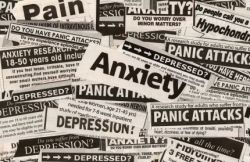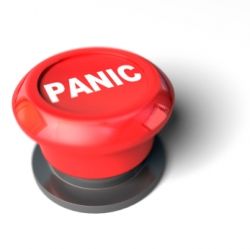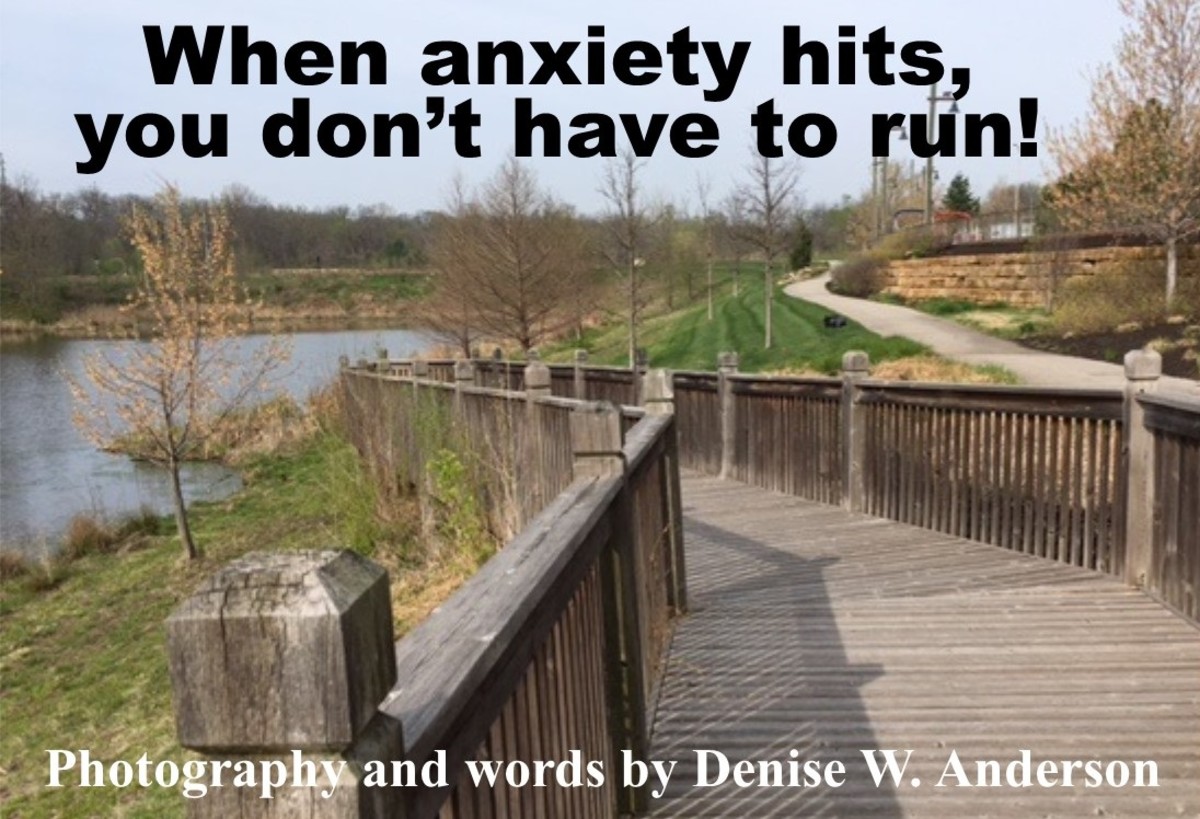- HubPages»
- Health»
- Mental Health»
- Anxiety Disorders
How to attack panic attacks

Panic attacks:what are they?
Do you awake from a deep sleep terrified for your life and have to run?
Are you having trouble going out of the house / into a lift / onto an escalator?
There are ways to manage your panic without drugs.
Images purchased from iStockphoto.com

What are panic attacks?
They go by lots of names
The Anxiety Panic Hub website tells us that there are three types of panic attacks.
Spontaneous panic attacks (uncued panic attacks) This particular panic attack is associated to Panic Disorder. This attack comes without any warning, day or night, irrespective of what the person is doing. The spontaneous attack is not related to, and is not induced by any particular situation or place. Many people can be woken from sleep with this type of attack.
Specific panic attacks (cued panic attacks) These occur in relation to specific feared situations or places. For example social situations for people with Social Anxiety. Revisiting the scene or scenes reminiscent of the traumatic events in Post Traumatic Stress Disorder or exposure to a particular anxiety producing situation in Obsessive Compulsive Disorder such as being exposed to germs.
Situational predisposed panic attacks People with Panic Disorder may experience this type of attack. Some people with Panic Disorder can be predisposed to having panic attacks in certain situations or places, although they are not frightened of the situation or place. For example someone may experience panic attacks while driving their car. Sometimes they will have them, other times they won't. They are predisposed to having attacks while driving, but the attacks are not a response to a fear of driving.
What are the symptoms of a panic attack?
Also from the Anxiety Panic Hub:
Symptoms of panic attacks can include palpitations, sweating, trembling or shaking, sensations of shortness of breath or smothering, feeling of choking, chest pain or discomfort, nausea or abdominal distress, dizziness or light-headedness, derealisation or depersonalisation, fear of losing control or going 'crazy', fear of dying, paresthesia, and chills or hot flushes'.... 'Attacks that have fewer than four symptoms are referred to as 'limited - symptom attacks.'
How did I get here?
When I was home in my bed?
I woke up outside the church on the next corner, about 500 metres from my house.
It was 1am and there were no people anywhere.
I had no recollection of getting there.
I seemed to recall being very afraid, and needing to 'GET OUT'.
This is what I used to do when an attack struck.

Get Out!
Run for your life!
Flee! Flee!
I would jump up from what seemed to be sleep, and have to run.
My pulse would be racing, my heart would feel as though it would burst, my hands would be clammy, and I would break out into a sweat.
My brain would be shouting at me that if I stayed I would DIE.
I have been known to be bruised as I shot out of a 'strange' bed in a friend's house, and scraped my shins as I went.
The fear was so strong that I would be impervious to any scratches or bangs as I fled.
Once I tore a zip in our tent open so violently that I broke it, unaware that I had done so.

Fight or flight?
Evolved response to danger
Back in the days of the cave man, sabre-tooth tigers were real, and very dangerous.
Early man knew to flee (the flight response) or to stand his ground and kill the tiger (the fight response).
This response is imprinted deep in our brains as a survival mechanism when danger is present — real or percieved.
We rarely need this response in modern times, thankfully, so sometimes our response mechanism works inappropriately in moments when we 'see' danger, awake or asleep, so we run from the 'tiger', or we attack it.
Photo courtesy: Wikimedia Commons

Attack those attacks
Using meditation techniques
You can learn to meditate in various ways:
- using CDs which are designed to assist you to meditate
- going to a therapist for training
- reading and studying the techniques
Once you start practising meditation, you will be surprised at how much calmer you will feel, and you can press the other button.
One of my CDs talks about a garden - with a wise person in it (me)

Perhaps this is your garden?

Attack them some more with CBT
Self talk is dangerous.
Cognitive behavioural therapy (CBT) will help you to stop this habit.
Are you the strong one?
Me: I can't do this, I'm too strong. I need to just get on with it.
Me: This is ridiculous, I can't fall apart, who will manage [this]? Or [that]?
Me (again!): I shouldn't be feeling like this!
Who says?
Me!
And by what authority?
Acceptance of self is a great healer
Accept you.
I had to learn to accept me as the now me.
Not what I used to be.
Or what I thought I should be.
If I learned as much as I could about my disorder, then I could also learn to manage it. But first I needed to learn to accept where I was at that time.
And in the end it wasn't so hard at all!
.
Very informative websites - they may help
- Anxiety Panic Hub - Help for people with an Anxiety Disorder
Anxiety Panic Hub - Anxiety & Panic Disorders Index - Panic Attacks (Panic Disorders) Symptoms, Causes, Treatment and Types on MedicineNet.com
Read about panic attack (panic disorder) symptoms, causes (stress, anxiety, fear) and treatment (medication, psychotherapy). Learn how to prevent panic attacks. - Panic Disorder - Panic attacks, symptoms of panic disorders - Anxiety Treatment Australia
Anxiety Treatment Australia provides information on anxiety disorders, depression, panic attacks, treatment & therapy including support groups & group therapy, a list of Australian psychologists who treat anxiety, and causes of shyness &
You won't die!
Nobody ever died
from a panic attack.
Calm deep breathing,
meditation, and
no self-talk,
will all help to overcome or
at least, manage your attacks.

Breathing exercises that really help
One of the first things I learned from the book, Power Over Panic, was to slow my breathing down during an attack.
At first it was so hard.
But if you practise slow breathing at other times when you are not in fight/flight mode, it will be part of your 'attack back' regimen.
Here's a simple exercise to try.
Slow breaths - in and out, in and out, in and out...
- In the beginning, start with five slow in-and-out breaths.
- In a few days, increase the number of breaths you take to ten.
- In a few more days, after you take an in breath, hold it for a count of three, then exhale.
When an attack strikes, start slowly breathing in and out, focussing on the breath.
Soon you can do this exercise at any time that you feel an attack coming on, and you will control the severity, or perhaps prevent it from happening.
One method:
- Sit comfortably, or lie down, in a quiet place.
- Take a breath in very slowly through your nose.
- Concentrate on the air coming into your body.
- Feel the coolness as you breathe the air in.
- Slowly exhale, concentrating on the breath as it leaves your body.
- Think only of your breathing.
- If thoughts come in, ignore them.
- Concentrate on slowly breathing in and out.
- Don't acknowledge the thoughts.
- Don't say "Stop!" to your mind.
- Distract your thought patterns by really focussing on the air as it comes in, and goes out.
- Relax your muscles as you breathe.
More excellent links - about anxiety/panic disorder
- The Anxiety Network
Especially recommend the Treatments and Therapies, then click Anxiety Education. Great information. - Anxiety Disorders - Health & Wellbeing
Anxiety isn't necessarily a problem. But when it becomes persistent, powerful and interferes with daily life, it's called an anxiety disorder. It can affect about one in 20 people. But sadly, only a tiny proportion of sufferers will seek treatment. - Panic Anxiety Disorder Association
panic anxiety disorder - Anxiety Disorders Association of America, ADAA, Triumph Over Anxiety, Find a Therapist
Resources for those suffering from or interested in learning more about generalized anxiety disorder (GAD), panic disorder, posttraumatic stress disorder (PTSD), obsessive-compulsive disorder (OCD), social anxiety disorder (social phobia), and specif

© 2016 Jan T Urquhart Baillie








